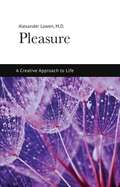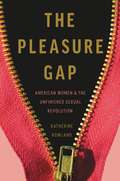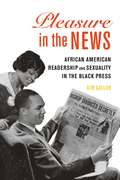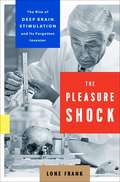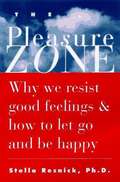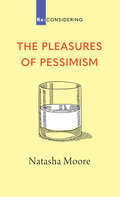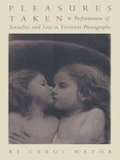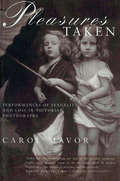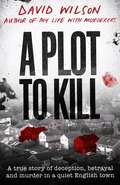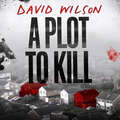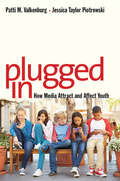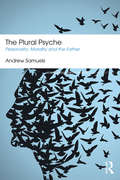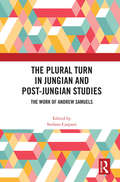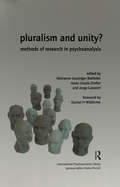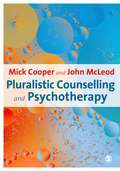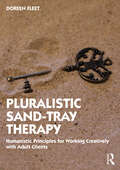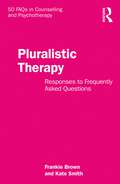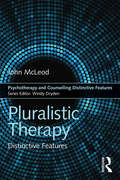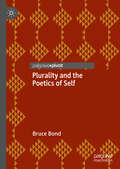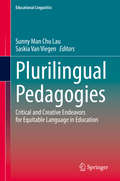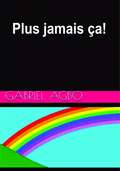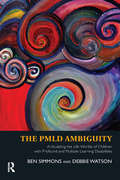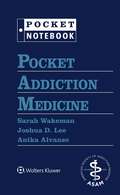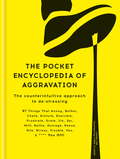- Table View
- List View
Pleasure: A Creative Approach to Life
by Alexander LowenIn Pleasure: A Creative Approach to Life, Alexander Lowen shows how the experience of pleasure or pain determines our emotions, thinking, and behavior. Lowen views the body as the outer manifestation of the spirit and defines grace as the divine spirit acting within the body. For the healthy individual the divine spirit is experienced as the natural gracefulness of the body and is reflected in the person's behavior. In a healthy body, movement, feeling, and thinking are integrated in grace and harmony. This book includes body-psychotherapy techniques and exercises aimed at alleviating muscular tension and restoring the body's natural grace. This spiritual grace involves a sense of connectedness to a higher order. In this state of grace we feel a kinship with all living creatures, and recognize our connection to our environment and to the world.
The Pleasure Gap: American Women and the Unfinished Sexual Revolution
by Katherine RowlandAmerican culture is more sexually liberal than ever. But compared to men, women's sexual pleasure has not grown: Up to 40 percent of American women experience the sexual malaise clinically known as low sexual desire. Between this low desire, muted pleasure, and experiencing sex in terms of labor rather than of lust, women by the millions are dissatisfied with their erotic lives. For too long, this deficit has been explained in terms of women's biology, stress, and age. In The Pleasure Gap, Katherine Rowland rejects the idea that women should settle for diminished pleasure; instead, she argues women should take inequality in the bedroom as seriously as we take it in the workplace and understand its causes and effects. Drawing on extensive research and interviews with more than one hundred women and dozens of sexual health professionals, Rowland shows that the pleasure gap is neither medical malady nor psychological condition but rather a result of our culture's troubled relationship with women's sexual expression. This provocative exploration of modern sexuality makes a case for closing the gap for good.
Pleasure in the News: African American Readership and Sexuality in the Black Press (New Black Studies Series #1)
by Kim GallonCritics often chastised the twentieth-century black press for focusing on sex and scandal rather than African American achievements. In Pleasure in the News, Kim Gallon takes an opposing stance—arguing that African American newspapers fostered black sexual expression, agency, and identity. <P><P> Gallon discusses how journalists and editors created black sexual publics that offered everyday African Americans opportunities to discuss sexual topics that exposed class and gender tensions. While black churches and black schools often encouraged sexual restraint, the black press printed stories that complicated notions about respectability. Sensational coverage also expanded African American women’s sexual consciousness and demonstrated the tenuous position of female impersonators, black gay men, and black lesbians in early twentieth African American urban communities. <P><P> Informative and empowering, Pleasure in the News redefines the significance of the black press in African American history and advancement while shedding light on the important cultural and social role that sexuality played in the power of the black press.
The Pleasure Shock: The Rise of Deep Brain Stimulation and Its Forgotten Inventor
by Lone FrankThe electrifying, forgotten history of Robert Heath's brain pacemaker, investigating the origins and ethics of one of today's most promising medical breakthroughs: deep brain stimulationThe technology invented by psychiatrist Robert G. Heath at Tulane University in the 1950s and '60s has been described as one of "the most controversial yet largely undocumented experiments in US history"--controversial to us because Heath's research subjects included incarcerated convicts and gay men who wished to be "cured" of their sexual preference; controversial in its day because his work was allegedly part of MKUltra, the CIA's notorious "mind control" project. As a result, Heath's cutting-edge research and legacy were put under lock and key, buried in Tulane's archives. The ethical issues raised by his work have also been buried: This very same experimental treatment is becoming mainstream practice in modern psychiatry for everything from schizophrenia, anorexia, and compulsive behavior to depression, aggression, anxiety, and even drug and alcohol addiction.In the first book to tell the full story, the award-winning science writer Lone Frank has uncovered lost documents and accounts of Heath's pioneering efforts. She has tracked down surviving colleagues and patients. And she has delved into the current embrace of deep brain stimulation by scientists and patients alike. What has changed? Why do we today unquestioningly embrace this technology as a cure? How do we decide what is a disease of the brain to be cured and what should be allowed to remain unprobed and unprodded? The Pleasure Shock weaves together biography, neuroscience, psychology, the history of science, and medical ethics to explore our views of the mind and the self. How do we decide whether changes to the brain are acceptable therapy or are simply bias and bigotry?
The Pleasure Zone: Why We Resist Good Feelings and How to Let Go and Be Happy
by Stella Resnick"When you are inspired by good feelings, there's no end to your energy." So says Dr. Stella Resnick, who has been concerned about how to help people stop focusing on what's wrong in their lives and start noticing what's right since 1978 when she wrote an article for New Age magazine that turned the therapy world on its ear. Now she has* distilled her years of work and collected extensive corroborative research to uncover the root of unhappiness-pleasure resistance. When people don't fully enjoy their lives and loves, it is usually because they have a fixed ceiling of how much pleasure they can tolerate. "There is an enormous untapped potential for pleasure in every one of us that has yet to be fully explored," she writes. While writers including Paul Pearsall, Deepak Chopra, Bernie Siegel, and Joan Borysenko have recently identified the benefits of pleasure, to a large extent they have been concerned with positive mental attitudes and visualizations. Dr. Resnick advances the exploration of pleasure further by linking optimism, physical health, emotional fulfillment in love, deeply gratifying sex, and positive aging to our ability to fully enjoy eight core pleasures. These are: primal pleasure, pain relief, the elemental pleasures of play and humor, and mental, emotional, sensual, sexual, and spiritual pleasure. In this ground-breaking work, Dr. Resnick discusses each core pleasure, pointing out subtle and not so subtle ways we deny ourselves and how each core pleasure is relevant to our health, emotional well-being, and interpersonal relationships. Complete with inspiring stories of people who have learned to reclaim pleasures they had cut themselves off from, each chapter concludes with a set of simple personal experiments designed to aid readers in gaining skill at enjoying that pleasure more completely. The Pleasure Zone is for anyone wanting to maintain a lifestyle based on being drawn rather than driven, and on fully celebrating all the pleasures of a lifetime.
The Pleasures of Pessimism (Re: CONSIDERING)
by Natasha MooreRe:CONSIDERING invites you to look at what’s familiar from an unfamiliar angle. To consider how we consider things – and how to do it better.Pandemic, supervolcano, late capitalism, transhumanism, populism, cancel culture, the post-antibiotic age, the gig economy, the surveillance state, the cascading effects of climate change …Whatever the specifics, do you ever feel like things are going off the rails - or are just about to?If you’ve read the news, watched a zombie movie, or gotten into an argument on Twitter lately, the answer is probably yes.And you’re not alone.What makes us such apocaholics?What’s so appealing about Armageddon? What are the pleasures - and also the perils of our pessimism?
The Pleasures of Reason in Plato, Aristotle, and the Hellenistic Hedonists
by James WarrenHuman lives are full of pleasures and pains. And humans are creatures that are able to think: to learn, understand, remember and recall, plan and anticipate. Ancient philosophers were interested in both of these facts and, what is more, were interested in how these two facts are related to one another. There appear to be, after all, pleasures and pains associated with learning and inquiring, recollecting and anticipating. We enjoy finding something out. We are pained to discover that a belief we hold is false. We can think back and enjoy or be upset by recalling past events. And we can plan for and enjoy imagining pleasures yet to come. This book is about what Plato, Aristotle, the Epicureans and the Cyrenaics had to say about these relationships between pleasure and reason.
Pleasures Taken: Performances of Sexuality and Loss in Victorian Photographs
by Carol MavorAn intimate look into three Victorian photo-settings, Pleasures Taken considers questions of loss and sexuality as they are raised by some of the most compelling and often misrepresented photographs of the era: Lewis Carroll's photographs of young girls; Julia Margaret Cameron's photographs of Madonnas; and the photographs of Hannah Cullwick, a "maid of all work," who had herself pictured in a range of masquerades, from a blackened chimney sweep to a bare-chested Magdalene. Reading these settings performatively, Carol Mavor shifts the focus toward the subjectivity of these girls and women, and toward herself as a writer.Mavor's original approach to these photographs emphatically sees sexuality where it has been previously rendered invisible. She insists that the sexuality of the girls in Carroll's pictures is not only present, but deserves recognition, respect, and scrutiny. Similarly, she sees in Cameron's photographs of sensual Madonnas surprising visions of motherhood that outstrip both Victorian and contemporary understandings of the maternal as untouchable and inviolate, without sexuality. Finally she shows how Hannah Cullwick, posing in various masquerades for her secret paramour, emerges as a subject with desires rather than simply a victim of her upper-class partner. Even when confronting the darker areas of these photographs, Mavor perseveres in her insistence on the pleasures taken--by the viewer, the photographer, and often by the model herself--in the act of imagining these sexualities. Inspired by Roland Barthes, and drawing on other theorists such as Julia Kristeva and Luce Irigaray, Mavor creates a text that is at once interdisciplinary, personal, and profoundly pleasurable.
Pleasures Taken: Performances of Sexuality and Loss in Victorian Photographs
by Carol MavorLewis Carroll's photographs of young girls, Julia Margaret Cameron's photographs of Madonnas and the photographs of Hannah Cullwick, "maid of all work", pictured in masquerade - Carol Mavor addresses the erotic possibilities of these images, exploring not ony the sexualities of the girls, maids and Madonnas, but the pleasures taken - by the viewer, the photographer, the model - in imagining these sexualities.
A Plot to Kill: A true story of deception, betrayal and murder in a quiet English town
by David Wilson'[A] real-life Midsomer Murder ... it's chilling, but [David Wilson's] explanation of how a psychopath thinks is masterly' The TimesThe shocking story of the murder of Peter Farquhar and the churchwarden who groomed and betrayed him, from the UK's leading criminologist David WilsonTwo deaths.Three doors apart.An unsuspecting community about to realise there's a killer in their midst. In October 2015, Peter Farquhar was found dead in his house in Maids Moreton, lying on the sofa next to a bottle of whisky. An inquest was made, and Peter's death was quickly ruled an accident.But after the death of another elderly neighbour, the dreadful truth began to emerge: both victims had been groomed, seduced and mentally tortured by a young man, Benjamin Field, who had used his position of power in the community to target and exploit the elderly.He almost got away with it. Very little shocks criminologist David Wilson, but this extraordinary case in his sleepy hometown astounded him. Wilson felt duty-bound to follow its trail, discovering how his tightknit community failed to intervene, how a psychopath went undetected for years, and how Peter unwittingly supplied the blueprint for his own murder.A Plot to Kill is a chilling, gripping account of a callous murder in the heart of middle England, a fight for justice, and a revealing insight into the mind of a killer.
A Plot to Kill: The notorious killing of Peter Farquhar, a story of deception and betrayal that shocked a quiet English town
by David Wilson'[A] real-life Midsomer Murder ... it's chilling, but [David Wilson's] explanation of how a psychopath thinks is masterly' The TimesThe shocking story of the murder of Peter Farquhar and the churchwarden who groomed and betrayed him, from the UK's leading criminologist David WilsonTwo deaths.Three doors apart.An unsuspecting community about to realise there's a killer in their midst. In October 2015, Peter Farquhar was found dead in his house in Maids Moreton, lying on the sofa next to a bottle of whisky. An inquest was made, and Peter's death was quickly ruled an accident.But after the death of another elderly neighbour, the dreadful truth began to emerge: both victims had been groomed, seduced and mentally tortured by a young man, Benjamin Field, who had used his position of power in the community to target and exploit the elderly.He almost got away with it. Very little shocks criminologist David Wilson, but this extraordinary case in his sleepy hometown astounded him. Wilson felt duty-bound to follow its trail, discovering how his tightknit community failed to intervene, how a psychopath went undetected for years, and how Peter unwittingly supplied the blueprint for his own murder.A Plot to Kill is a chilling, gripping account of a callous murder in the heart of middle England, a fight for justice, and a revealing insight into the mind of a killer.
Plugged In: How Media Attract and Affect Youth
by Jessica Taylor Piotrowski Patti M. ValkenburgAn illuminating study of the complex relationship between children and media in the digital age Now, as never before, young people are surrounded by media—thanks to the sophistication and portability of the technology that puts it literally in the palms of their hands. Drawing on data and empirical research that cross many fields and continents, authors Valkenburg and Piotrowski examine the role of media in the lives of children from birth through adolescence, addressing the complex issues of how media affect the young and what adults can do to encourage responsible use in an age of selfies, Twitter, Facebook, and Instagram. This important study looks at both the sunny and the dark side of media use by today’s youth, including why and how their preferences change throughout childhood, whether digital gaming is harmful or helpful, the effects of placing tablets and smartphones in the hands of toddlers, the susceptibility of young people to online advertising, the legitimacy of parental concerns about media multitasking, and more.
The Plural Psyche: Personality, Morality and the Father (Routledge Mental Health Classic Editions)
by Andrew SamuelsPluralism can bridge the gaps that have opened up between personal experience, psychotherapy, and cultural criticism. In The Plural Psyche: Personality, Morality and the Father, a provocative, much praised and widely discussed book, Andrew Samuels lays bare the political implications of the personal struggle everyone has to hold their many inner divisions together. He also shows how pluralism can inspire new thinking in many areas including moral process, the construction of gender, and the role of the father in the development of sons and daughters. In addition, there are innovative chapters on clinical work, focusing on imagery and on countertransference. These themes come to life in a way that makes a significant contribution to debates about psychotherapy, gender, parenting and difference. This Classic Edition of The Plural Psyche includes a new introduction by the author.
The Plural Turn in Jungian and Post-Jungian Studies: The Work of Andrew Samuels
by Stefano CarpaniThis unique book showcases the cutting-edge work of researchers in Jungian and post-Jungian studies, focusing on the advances being made at the University of Essex, UK, and operating as a Festschrift for Professor Andrew Samuels. The Plural Turn in Jungian and Post-Jungian Studies includes contributions from innovative authors who specialise in Jung but incorporate ideas from other psychoanalytic schools and from a range of disciplines. The book includes chapters which shed new light on concepts including alchemy, archetypes and individuation and which examine art, relationships and politics. It both honours the work of Andrew Samuels and sets the foundations of an ‘Essex School’ of Jungian studies. A wide-ranging collection, this book will be essential for academics and scholars of Jungian and post-Jungian studies. It will also be a key title for all readers with an interest in the work of Andrew Samuels.
Pluralism and Unity?: Methods of Research in Psychoanalysis
by Jorge CanestriThis book compiles the papers presented at an International Conference, "Pluralism of Sciences: The Psychoanalytic Method between Clinical, Conceptual and Empirical Research" in 2002. It provides the variety and diversity of psychoanalytic research cultures in different psychoanalytic societies.
Pluralistic Counselling and Psychotherapy: Distinctive Features (Psychotherapy And Counselling Distinctive Features Ser.)
by Mick Cooper John McLeodMick Cooper and John McLeod pioneer a major new framework for counselling theory, practice and research - the ′pluralistic′ approach. This model breaks away from the orientation-specific way in which counselling has traditionally been taught, reflecting and responding to shifts in counselling and psychotherapy training. As accessible and engaging as ever, Cooper and McLeod argue that there is no one right way of doing therapy and that different clients need different things at different times. By identifying and demonstrating the application of a range of therapeutic methods, the book outlines a flexible framework for practice within which appropriate methods can be selected depending on the client′s individual needs and the therapist′s knowledge and experience. This is a must-read for anybody training or practising in the counselling or helping professions - it should not be missed!
Pluralistic Sand-Tray Therapy: Humanistic Principles for Working Creatively with Adult Clients
by Doreen FleetIn this book, Fleet provides the first comprehensive guide to implementing sand-tray therapy within a pluralistic framework. Pluralistic Sand-Tray Therapy offers several unique contributions to a theoretical understanding of the therapeutic process, including the dynamic phenomenological field incorporating the concept of phenomenological shift and the introduction to two sand-tray specific mechanisms that aid the therapeutic process by facilitating the client’s discovery in a unique way. Theory is applied to practice with step-by-step detailed guidance on how to deliver effective pluralistic sand-tray therapy from the initial appointment to the end of therapy. Each theoretical concept and practical direction is supported by case study findings, including photographs taken during real sessions. This book will be an essential text for academics and students of psychotherapy and counselling seeking to understand the impact and implementation of sand-tray therapy. It also offers a complete guide for practicing counsellors and psychotherapists, including arts and play therapists, who wish to use sand-tray therapy in their work.
Pluralistic Therapy: Responses to Frequently Asked Questions (50 FAQs in Counselling and Psychotherapy)
by Frankie Brown Kate SmithPluralistic Therapy provides answers to the most important and common questions asked about the origins, principles and practice of pluralism. Written in an accessible style by experts in the field, the book provides the reader with a comprehensive understanding of the pluralistic approach in theory and practice, and builds on the contemporary developments in the field. The questions cover five areas, including an overview of pluralism, pluralism in practice, client factors, pluralistic developments outside of individual therapy and critical questions about pluralism. The questions also cover some of the key challenges posed to the approach. This book will appeal to a wide range of audiences, including therapeutic practitioners, researchers, and professionals interested in the application of the approach within mental health contexts. It will also serve to help professionals from non-therapy backgrounds such as mental health services, education, and social care understand the nature of pluralistic work.
Pluralistic Therapy: Distinctive Features (Psychotherapy and Counselling Distinctive Features)
by John McLeodPluralistic Therapy: Distinctive Features offers an introduction to what is distinctive about this increasingly popular method. Written by one of the co-founders of pluralistic therapy, and a leading UK figure in counselling and psychotherapy, this book describes 15 theoretical features and 15 practical techniques for practitioners. Pluralistic therapy is a flexible, integrative approach to counselling and psychotherapy, which has also found applications in fields such as mental health, life coaching and careers guidance. Pluralistic Therapy: Distinctive Features will provide an essential guide to students and practitioners of psychotherapy, or an allied area of practice, who are open to learning about new ideas and techniques from current interdisciplinary research.
Plurality and the Poetics of Self
by Bruce BondPlurality and the Poetics of Self investigates the words “I” and “self” as suggestive of eight territories of meaning. Via poetry’s lens into language and its limits, Bruce Bond explores the notion of self as identity, volitional agent, ego, existential monad, subjectivity, ontological origin, soul, and transpersonal psyche. Taking poetic meaning as our common currency, the book emphasizes the critical role of the un-representable and how embattled and confused assumptions threaten ever deeper alienation from one another and ourselves.
Plurilingual Pedagogies: Critical and Creative Endeavors for Equitable Language in Education (Educational Linguistics #42)
by Sunny Man Chu Lau Saskia Van ViegenThis book critically engages with theoretical shifts marked by the ‘multilingual turn’ in applied linguistics, and articulates the complexities associated with naming and engaging with the everyday language practices of bi/multilingual communities. It discusses methodological approaches that enable researchers and educators to observe and interact with these communities and to understand their teaching and learning needs. It also highlights pedagogical approaches and instructional strategies involved with learning and teaching language and/or content curriculum to students across various learning and educational contexts. The book addresses recent debates on the multi/plural turn in applied linguistics and articulates the limitations of these debates - particularly the absence of discussion of social power relations and contexts in applying different theoretical lenses. It features empirical research from primarily North American classrooms to highlight how plurilingual pedagogies take shape in unique educational contexts, resisting monolingual approaches to language in education. Furthermore, it includes commentary/response pieces from established scholars in dialogue with recent plurilingual research in the field, to put the work in critical perspective within extant theories and literature.
Plus jamais ça!
by Gabriel Agbo«Le SEIGNEUR dit:« Je vous rendrai ce que vous avez perdu aux criquets pèlerins, aux criquets pèlerins, aux criquets grouillants et aux sauterelles sautillantes… Jamais plus mon peuple ne sera déshonoré comme ça. Alors vous saurez que je suis ici parmi mon peuple d'Israël et que je suis seul l'Éternel, votre Dieu. Mon peuple ne sera plus jamais déshonoré comme ça. » Joël 2: 25-27 Il est temps d'arrêter ces choses qui veulent vous arrêter. C'est la volonté de Dieu d'arrêter tout ce qui veut vous retirer de ses plans pour votre vie. Et vous savez déjà que son plan pour vous est d'avoir le meilleur de la joie, de la paix, de la prospérité, de la miséricorde, de la bonne santé et de posséder tous vos biens. Même si vous êtes sous son jugement, il peut être inversé aujourd'hui et vous recommencerez à nager dans sa grâce. Nous avons également examiné les expériences des autres et la version israélienne moderne de Never Again. Pourquoi ont-ils adopté ce slogan et jusqu'où sont-ils allés pour le faire respecter? Bien sûr, Israël est devenu aujourd'hui l'une des nations les plus puissantes sur terre (Il a la meilleure organisation intelligente - le Mossad et la troisième meilleure armée du monde) non seulement parce que Dieu est avec eux, mais parce qu'ils ont également juré de ne jamais permettre Les Juifs subissent les traitements, les douleurs, la tristesse et les morts les plus déshumanisants qu'ils ont connus lors des événements malheureux et évitables du siècle dernier. Aujourd'hui, ils mènent non seulement la défense, mais aussi l'agriculture, les TIC, la science et la médecine. Oui, nous pouvons dire plus jamais aujourd'hui! Ce livre est certainement une lecture intéressante. «Le SEIGNEUR dit:« Je vous rendrai ce que vous avez perdu aux criquets pèlerins, aux criquets pèlerins, aux criquets grouillants et aux sauterelles sautillantes… Jamais plus mon peuple ne sera désho
The PMLD Ambiguity: Articulating the Life-Worlds of Children with Profound and Multiple Learning Disabilities
by Ben Simmons Debbie WatsonThis book challenges the very idea of "profound and multiple learning disabilities" (PMLD) itself, and what constitutes appropriate educational provision for children described as having PMLD. It considers the role of ambiguity in articulating the life-worlds of children with PMLD.
Pocket Addiction Medicine (Pocket Notebook Series)
by Sarah E. Wakeman Joshua D. Lee Anika A.H. AlvanzoA new volume in the bestselling Pocket Notebook series, Pocket Addiction Medicine delivers highly relevant coverage of this widespread and increasing health care problem in an easily portable source. Edited by physician leaders in Addiction Medicine, Drs. Sarah E. Wakeman, Joshua D. Lee, and Anika Alvanzo and co-published with the American Society of Addiction Medicine (ASAM), this handbook provides must-know information on everything from screening for and diagnosis of substance use disorder to managing intoxication and withdrawal, to ongoing treatment of substance use disorder, including caring for special populations—all designed for quick reference at the point of care. Using the popular, easy-access Pocket Notebook format, it puts key clinical information about a broad range of issues in addiction medicine at your fingertips in seconds.
The Pocket Encyclopedia of Aggravation: The Counterintuitive Approach to De-stressing
by Laura LeeAaarghgghhh!!@#%&*!!! Every time your mobile phone rings, it's an automated PPI call... You've forgotten one of your million different internet passwords... Once again, you're stuck in the slowest lane at the supermarket...This book investigates 97 day-ruining events, slap-in-the-face moments and everyday aggravations, and explains why these things irritate us quite so much. Let's face it, the world is becoming an increasingly annoying place to live - and THE POCKET ENCYCLOPEDIA OF AGGRAVATION has the evidence to prove it. It has been scientifically proven that when we understand the science behind our daily grievances, our problems become less frustrating and easier to manage. This fact-filled book will help reduce the stress of your daily grind. Designed with enlightening diagrams and witty drawings, THE POCKET ENCYCLOPEDIA OF AGGRAVATION finally answers the question, why is that so f*cking annoying?
